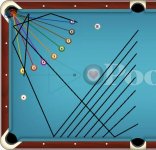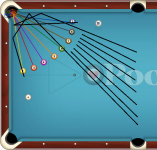Boy Eye-man, are you sure you're not older than me ?..You sure are set in your ways !..I'm not satisfied with your answer on paragraph 2..Who gives a shite what Mika is doing ?...You did not address my thoughts on WHY commentators act surprised, at the use of inside english, when it is uncalled for...By the way, I know many different ways to 'kill' my cue ball, coming off a thin cut..(straight draw is one way, unless its too close to the rail)
Just for grins, I used to add a little challenge to cutting the long frozen 2 ball, the length of the table..I would put the cue ball, on a piece of chalk, on the wooden part of the end rail, and cut it in either pocket ! (I would bet I could do it, in under 6 tries)..Naturally, this shot calls for exxxtreeeeme inside english, so you would REALLY love it !

PS..BTW...You win the speed typing contest...hands down ! :sorry:
I think the commentators are surprised because THEY don't understand inside English. It is only UNNATURAL because they haven't used it ENOUGH to make it NATURAL. To ME, inside is as natural as outside. I use both and I'm not advocating that everyone play this style. Play whatever you play best with. Whatever English you use is "uncalled for" if you get out of line...I get out of line WAY LESS using inside.
And I LOVE the shot you described. I done it hundreds of times. I remember St Louis Louie betting he could do it 1 out of 3 if I remember correctly when I saw him last.
I have a shot that I make every weekend with a few tries that has WAY more inside than that. Look at the diagram I posted with the 2 on the end rail and the cue ball where it is. Now move the cue ball along the same line but one diamond or more closer to the rail where the 3 is. Now cut the 2 in the left corner...the one on the same rail that the 3 is sitting on. That requires a bit of INSIDE.
Last edited:



